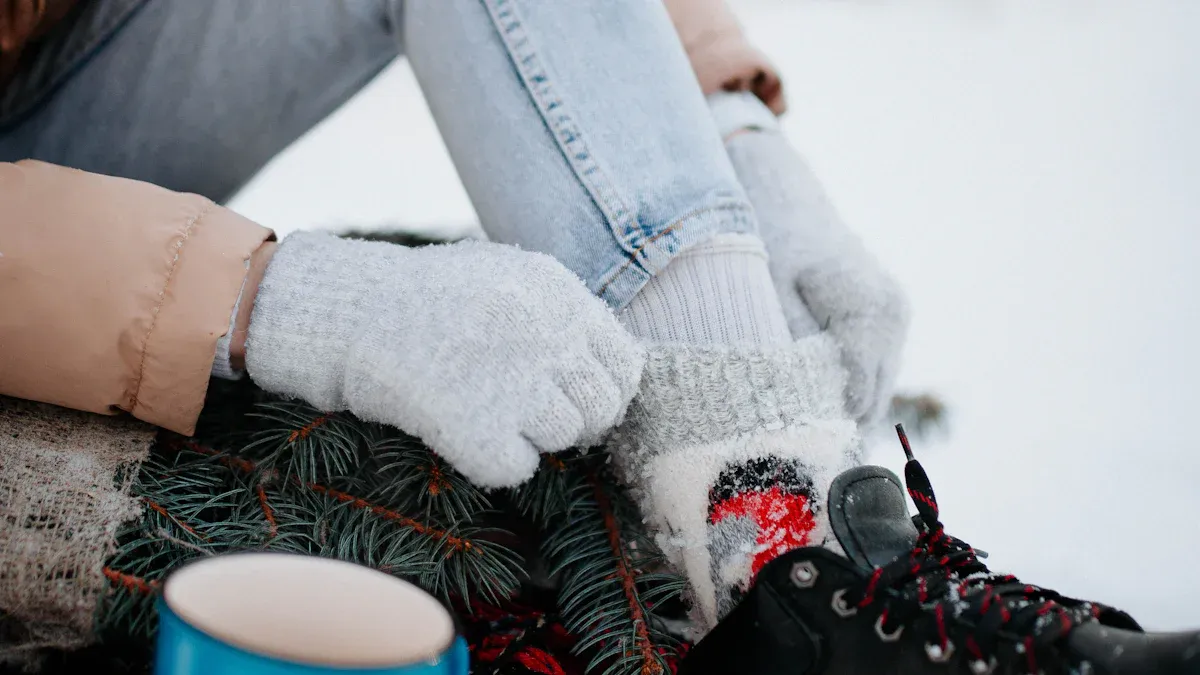
When I first started hiking, I didn’t think much about socks. But let me tell you, the right pair can make or break your day on the trail. Choosing the right socks is key to a comfortable hike, and factors like thickness, weather, and boot fit all play a role in finding what works best for you.
Thick socks, for example, are a game-changer in cold weather. They provide extra warmth and cushioning, making them perfect for winter hikes. Manufacturers design socks in different thicknesses—lightweight for most seasons, midweight or heavyweight for colder conditions—to suit specific needs and keep your feet cozy on the trail.
However, thick socks aren’t always the best choice. If it’s hot or your boots are snug, they might cause discomfort or overheating. So, it’s all about finding the right balance for your feet, matching sock thickness to the season and your hiking gear for the best experience.
Key Takeaways
- Thick socks keep your feet warm and soft, great for cold hikes.
- They stop blisters by lowering rubbing and adding soft padding.
- Pick sock thickness based on weather, trails, and boot fit.
- Thick socks may make feet too hot in warm weather. Use thin socks then.
- Always try socks with boots before hiking to stay comfy.
- Wearing a thin sock under a thick one keeps feet dry and blister-free.
- Thick socks last longer because they have strong stitching.
- Bring extra socks in case your feet get wet or sweaty.
Why Thick Socks Are Important for Hiking?
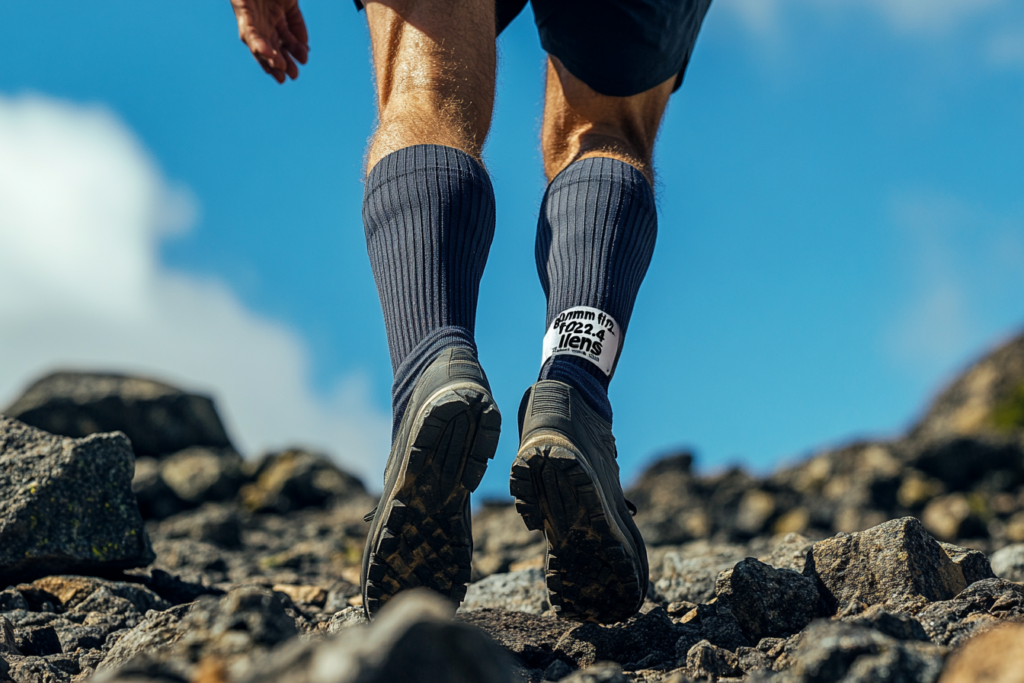
The Role of Thick Socks in Hiking
When I think about hiking, I always picture long trails, uneven terrain, and hours of walking. That’s why I believe thick socks are more than just an accessory—they’re a necessity. They play a huge role in keeping your feet comfortable and protected during a hike. For starters, they provide extra padding that cushions your feet from the constant impact of walking. This is especially important for sensitive areas like your heels, toes, and ankles. Without that padding, you’re more likely to end up with blisters or sore spots.
Another thing I’ve noticed is how thick socks help with durability. Hiking involves way more steps than regular walking, and your socks need to keep up. Premium hiking socks often come with reinforced stitching and extra padding, which makes them last longer and perform better. Plus, they can even improve your gait and step form, which is a bonus for anyone tackling tough trails.
And let’s not forget about warmth. If you’re hiking in cold weather, thick socks act like a cozy blanket for your feet. They trap heat and keep you comfortable, even when the temperature drops. But it’s not just about warmth—they also absorb impacts, which can make a big difference on rocky or uneven paths. For me, that extra cushioning has been a lifesaver on more challenging hikes.
Common Misconceptions About Thick Socks
I’ve heard a lot of myths about thick socks, and honestly, some of them just don’t hold up. One common misconception is that thicker socks are always better. While they do provide more warmth and cushioning, they can also reduce breathability. That’s why they’re not ideal for every situation. For example, if you’re hiking on a hot day, thinner socks might actually be a better choice. They’re designed to keep your feet cool and dry, which is crucial in warmer conditions.
Another myth is that thick socks are only for winter hikes. That’s not entirely true. Mid-thickness socks can be a great option for tougher hikes in warm weather. They strike a balance between warmth and breathability, making them versatile for different conditions. I’ve even used lightweight socks for casual hikes in temperatures between 40 and 80 degrees Fahrenheit, and they worked perfectly.
Lastly, some people think heavier socks are always the best choice for long hikes. While they do offer more protection, they can cause moisture issues if the weather isn’t cold enough. I’ve learned that choosing the right sock thickness depends on the trail, the weather, and even the type of boots you’re wearing. It’s all about finding what works best for you.
2.What's the Pros and Cons of Thick Socks for Hiking?
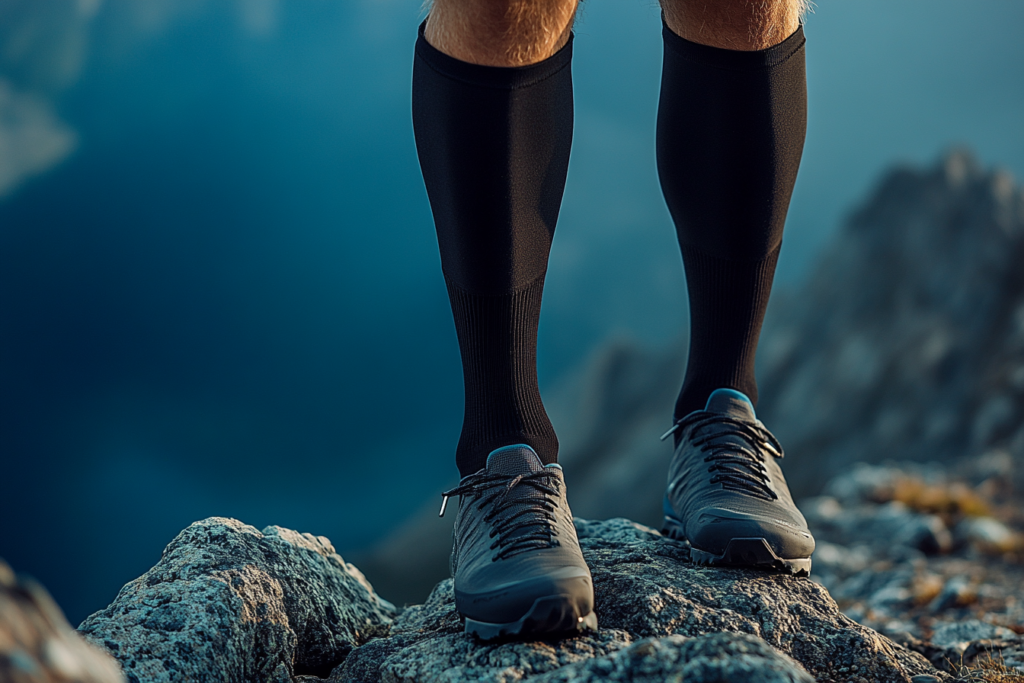
Benefits of Thick Socks
Thick socks have been a lifesaver for me on many hikes. One of the biggest advantages is the extra cushioning they provide. When you're walking on rocky trails or uneven ground, that padding can make a huge difference. It reduces the impact on your feet, especially on long hikes. I’ve noticed that my feet feel less sore after a day of trekking when I wear thicker socks.
Another great thing about thick socks is their ability to keep your feet warm. If you’ve ever hiked in cold weather, you know how quickly your toes can freeze. Thick socks act like a cozy barrier, trapping heat and keeping your feet comfortable. This is especially helpful during winter hikes or early morning starts when the temperature is low.
Durability is another reason I love thick socks. They’re often made with reinforced stitching, which means they last longer than thinner options. I’ve had pairs that survived multiple hiking seasons without wearing out. Plus, they protect your feet from blisters by reducing friction inside your boots. For me, that’s a game-changer.
Drawbacks of Thick Socks
While thick socks have their perks, they’re not perfect. One issue I’ve faced is overheating. On warmer days, my feet can get uncomfortably hot, and that leads to sweating. Sweaty feet not only feel gross but can also cause itching around the calves. It’s something to keep in mind if you’re hiking in moderate or hot weather.
Another problem is the fit. If your socks are too tight, they can cut off circulation. I’ve experienced swelling and tenderness after wearing socks that were a bit too snug. On the flip side, loose socks can slide down into your boots. When that happens, it creates friction, and blisters can form. It’s frustrating to stop mid-hike to adjust your socks.
Here’s a quick look at some common drawbacks of thick socks:
| Drawback | Explanation |
|---|---|
| Overheating | In moderately warm weather, thick socks can cause feet to feel overheated and calves itchy. |
| Poor fit leading to blisters | Socks that are too tight can cut off circulation, leading to swelling, bruising, and tenderness. |
| Sliding down | Loose socks can slide down in boots, increasing the risk of developing blisters while walking. |
So, while thick socks are great in many situations, they’re not always the best choice. It’s all about knowing when and where to use them.
3.When to Wear Thick Socks (and When to Avoid Them)?
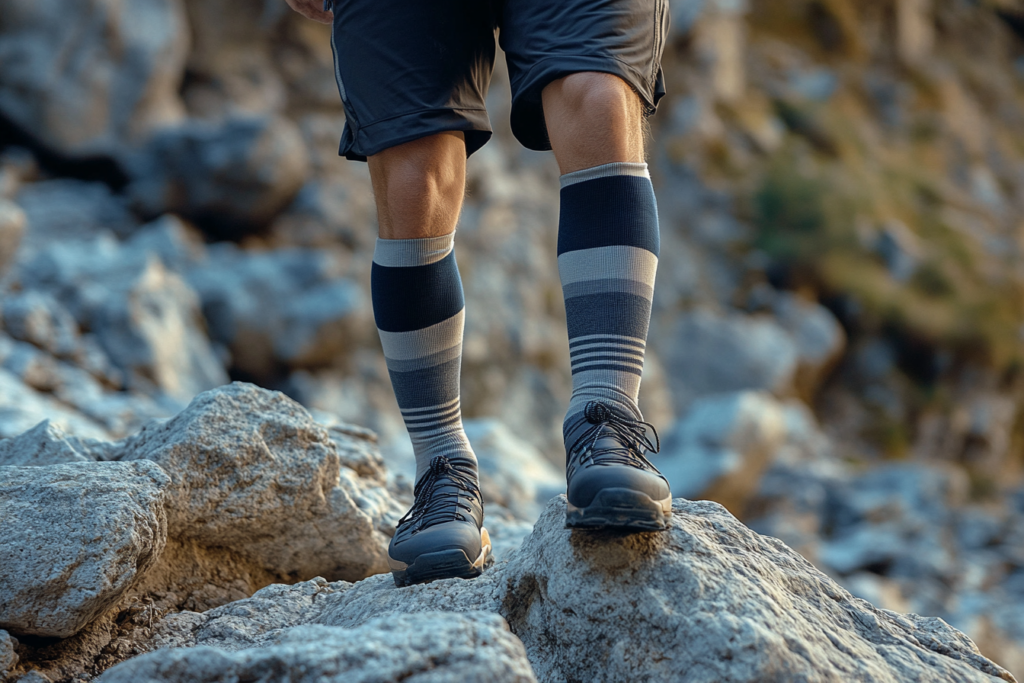
Best Scenarios for Thick Socks
Thick socks shine in specific hiking conditions. I’ve found them to be a must-have for cold weather hikes. They trap heat and keep my feet warm, even when the temperature drops below freezing. For winter hiking or mountaineering, heavyweight socks made from materials like Merino wool are unbeatable. They provide warmth and cushioning, which is essential when trekking through snow or icy trails. Brands like Darn Tough and Smartwool make excellent options for these conditions.
Demanding hikes are another scenario where thick socks come in handy. If you’re carrying a heavy pack or tackling rocky terrain, the extra padding can save your feet from soreness. I’ve noticed that my feet feel less fatigued after long hikes when I wear socks with medium to heavy cushioning. They absorb the impact of each step, especially on uneven trails.
Here are some situations where thick socks work best:
- Cold weather: They keep your feet warm and dry.
- Tough terrain: Extra padding protects your feet from sharp rocks.
- Heavy packs: More cushioning helps reduce foot strain.
- Stiff boots: Thick socks fill the space and prevent blisters.
Tip: Always match your socks to the climate and trail conditions. For cold days, heavyweight Merino blends are ideal. For moderate weather, medium cushioning strikes a good balance.
Situations to Avoid Thick Socks
Thick socks aren’t always the right choice. I’ve learned this the hard way on hot summer hikes. They can make your feet overheat, leading to excessive sweating. Even socks with moisture-wicking properties can feel uncomfortable in high temperatures. For warm weather, lightweight socks with no or light cushioning work much better. They keep your feet cool and dry, which is crucial for avoiding blisters.
Another issue is fit. Thick socks can make snug boots feel too tight, cutting off circulation. I’ve experienced swelling and discomfort after wearing thick socks with boots that didn’t have enough room. On the flip side, if the socks are too loose, they can bunch up and cause friction. This often leads to blisters, which can ruin a hike.
Here’s when to skip thick socks:
- Hot weather: They trap heat and cause sweating.
- Tight boots: They can restrict circulation and cause discomfort.
- Casual hikes: Lightweight socks are more breathable and comfortable.
Note: Always test your socks and boots together before a hike. A proper fit can make all the difference in your comfort.
4.How to Choose the Right Hiking Socks?
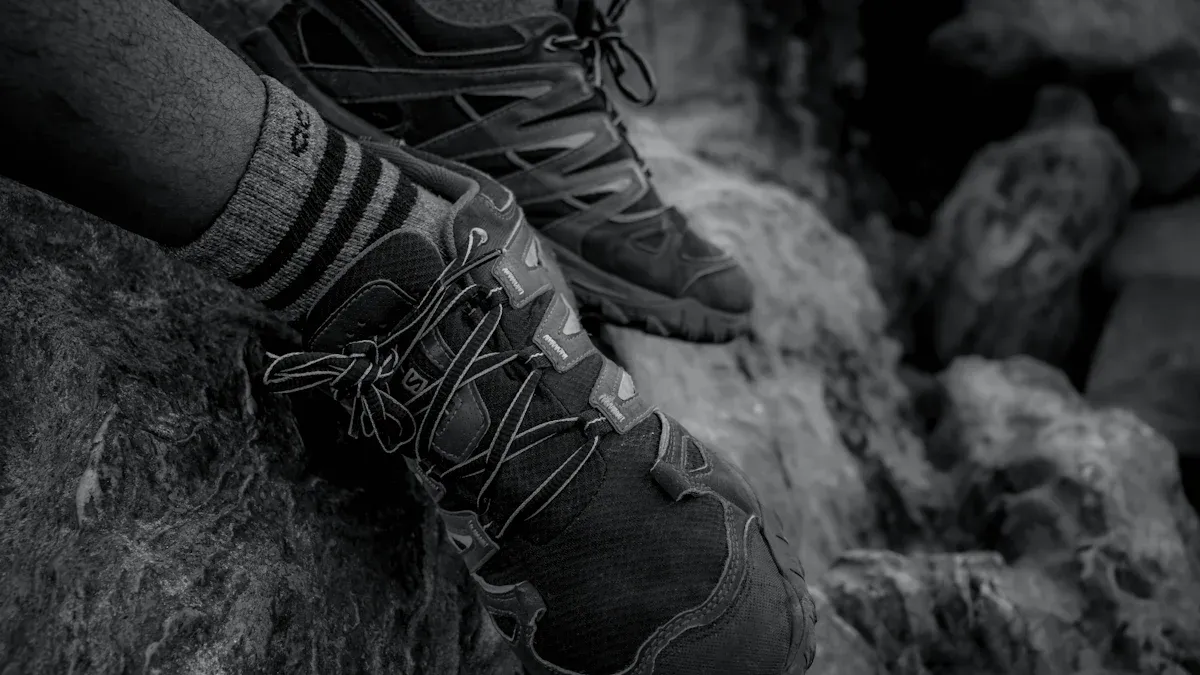
Material Matters for Thick Socks
When it comes to hiking socks, the material can make or break your experience. I’ve learned the hard way that cotton is a no-go. It traps moisture, which can lead to blisters and discomfort. Instead, I always go for materials like Merino wool or synthetic fibers. Merino wool is my favorite because it keeps my feet warm even when it’s wet and helps fight odors. Synthetic options like polyester or nylon are also great for wicking moisture and drying quickly.
I’ve noticed that socks with a higher wool content—around 74% or more—offer the best warmth and comfort. For example, brands like Smartwool and REI Co-op make excellent thick socks for cold-weather hikes. On the other hand, socks with less wool, like the Danish Endurance Unisex Merino, don’t insulate as well. So, if you’re planning a winter hike, go for socks with a higher wool percentage. They’ll keep your feet cozy and dry, even in challenging conditions.
Tip: Always check the material label before buying hiking socks. Avoid cotton and look for blends with Merino wool or synthetic fibers for the best performance.
The Importance of Sock and Boot Fit
I can’t stress enough how important it is to get the right fit for both your socks and boots. If your socks are too loose, they’ll bunch up and cause friction, which leads to blisters. On the flip side, socks that are too tight can cut off circulation and make your feet swell. I’ve experienced both, and trust me, it’s not fun.
To avoid these issues, I always make sure my socks fit snugly without being too tight. They should cover my ankles to protect against chafing. I also match the sock height to my boots. For example, taller socks work best with high-cut boots, while shorter ones are fine for low-cut hiking shoes. This simple step has saved me from a lot of discomfort on the trail.
Note: Knowing your actual foot size—not just your shoe size—can help you find the perfect sock fit. A proper fit prevents wrinkles and pressure points, keeping your feet happy during long hikes.
Layering Techniques for Comfort and Protection
Layering socks might sound unnecessary, but it’s a game-changer for certain hikes. I’ve found that wearing a thin liner sock under a thicker pair can help prevent blisters. The liner wicks away moisture, while the outer sock provides cushioning and warmth. This combo works especially well on long hikes or in cold weather.
When layering, I stick to materials like Merino wool or synthetic fibers. They keep my feet dry and warm, even if the outer layer gets wet. Avoid cotton liners, as they’ll just trap moisture and make things worse. I’ve also noticed that layering works best with boots that have a little extra room. If your boots are too snug, adding a second sock layer might make them uncomfortable.
Pro Tip: Experiment with layering on shorter hikes before committing to it on a long trek. This way, you can figure out what works best for your feet and boots.
5.What's the Insights from Experienced Hikers?
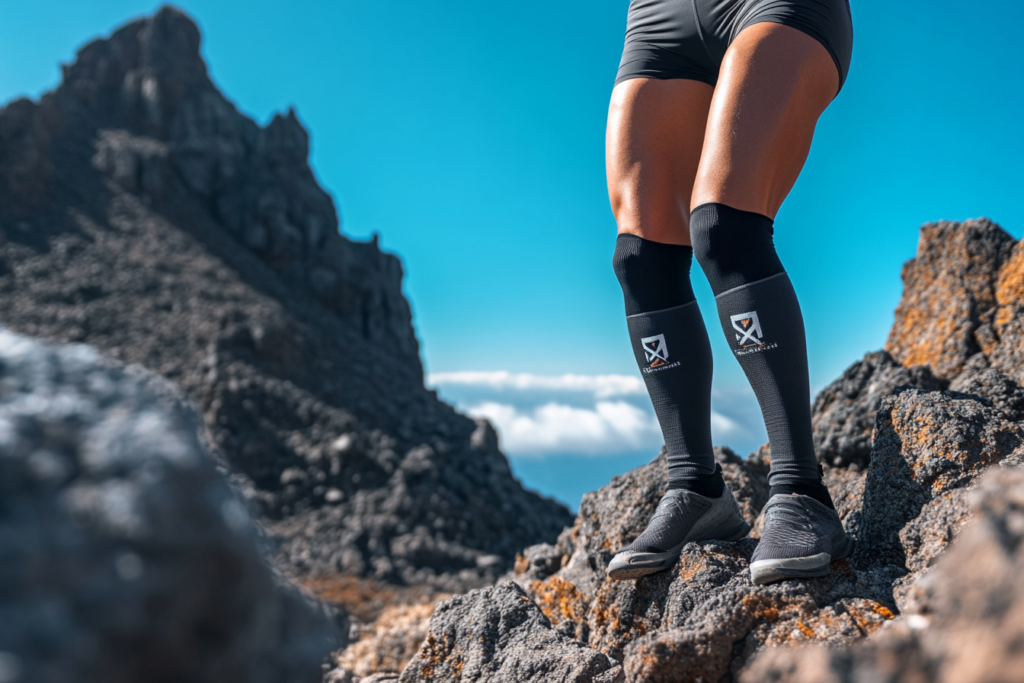
What Hikers Say About Thick Socks
I’ve talked to a lot of hikers over the years, and opinions about thick socks vary. Some swear by them, especially for cold-weather hikes. They say thick socks keep their feet warm and comfortable, even on icy trails. Others love the extra cushioning, which helps reduce foot fatigue during long treks. One hiker told me that thick socks saved her from blisters on a rocky trail because they added just enough padding to prevent rubbing.
But not everyone is a fan. A few hikers I’ve met avoid thick socks altogether, especially in warm weather. They say their feet overheat and sweat too much, which leads to discomfort. One guy shared that he switched to lightweight socks for summer hikes and never looked back. He said thinner socks kept his feet cooler and drier, even on hot days.
Here’s the takeaway: thick socks work great for some hikers, but they’re not a one-size-fits-all solution. It really depends on the weather, the trail, and your personal preferences.
Preferences and Tips from the Hiking Community
The hiking community has a lot of advice when it comes to socks. One tip I hear often is to test your socks before a big hike. A short walk around your neighborhood can help you figure out if they’re comfortable and if they fit well with your boots. Another popular suggestion is to carry an extra pair of socks. If your feet get wet or sweaty, swapping out your socks can make a huge difference.
Many hikers also recommend layering socks for added protection. A thin liner sock under a thicker pair can help prevent blisters and keep your feet dry. I’ve tried this trick myself, and it works wonders on longer hikes. Just make sure your boots have enough room for the extra layer.
When it comes to materials, hikers seem to agree on one thing: avoid cotton. Wool and synthetic blends are the top choices because they wick moisture and dry quickly. Merino wool, in particular, gets a lot of praise for its warmth and odor resistance. One hiker I met swears by Merino wool socks for winter hikes, saying they’re worth every penny.
Tip: Always listen to your feet. If your socks feel too tight or too loose, switch them out. Comfort is key when you’re spending hours on the trail.
Conclusion
Thick socks can make or break your hiking experience. I’ve found they’re a great asset when the conditions are right. Cold weather? Rocky trails? They’re perfect. But they’re not always the best choice. I always consider the weather, terrain, and how my boots fit before deciding. Testing socks on shorter hikes has saved me from discomfort more than once. And here’s my golden rule: always carry an extra pair. Wet or sweaty feet can ruin a hike, but a fresh pair of socks can save the day.
FAQ
What’s the best material for thick hiking socks?
I always recommend Merino wool or synthetic blends. Merino wool keeps your feet warm, wicks moisture, and resists odors. Synthetic fibers like polyester dry quickly and add durability. Avoid cotton—it traps moisture and causes blisters.
Tip: Check the material label before buying. Look for at least 70% Merino wool for cold-weather hikes.
Can I wear thick socks in summer?
I wouldn’t recommend it. Thick socks can make your feet overheat and sweat in hot weather. Lightweight socks with moisture-wicking properties work better for summer hikes. They keep your feet cool and dry, reducing the risk of blisters.
How do I prevent blisters with thick socks?
Blisters happen when there’s friction. To avoid them, make sure your socks fit snugly and don’t bunch up. I also layer a thin liner sock under thicker ones for extra protection. This combo reduces rubbing and wicks away moisture.
How many pairs of socks should I bring on a hike?
I always carry at least one extra pair. If your socks get wet or sweaty, swapping them out can save your feet. For multi-day hikes, I pack a fresh pair for each day and a backup just in case.
Are thick socks better for long hikes?
It depends on the conditions. Thick socks provide cushioning and warmth, which is great for cold weather or rocky trails. But for warm weather or casual hikes, lightweight socks might be more comfortable. Always match your socks to the trail and weather.
Do thick socks work with all hiking boots?
Not always. Thick socks can make snug boots feel too tight, causing discomfort. I always test my socks and boots together before a hike. If your boots are roomy, thick socks can help fill the space and prevent blisters.
Should I layer socks for every hike?
Not necessarily. Layering works best for long hikes or cold weather. A thin liner sock wicks moisture, while a thicker outer sock adds cushioning. For short or warm-weather hikes, a single pair of lightweight socks usually does the job.
Pro Tip: Test layering on shorter hikes to see if it works for you.
How do I choose the right sock thickness?
Think about the weather, trail, and your boots. For cold weather or tough terrain, go with midweight or heavyweight socks. For warm weather or casual hikes, lightweight socks are better. I always test different thicknesses on short hikes to find what feels best.
